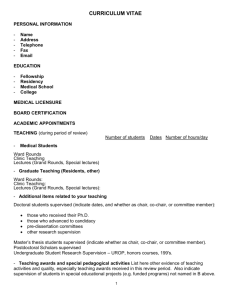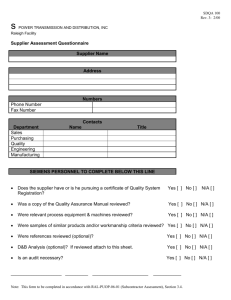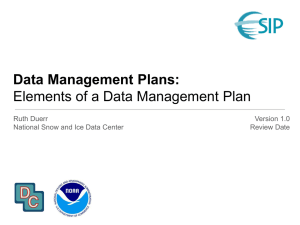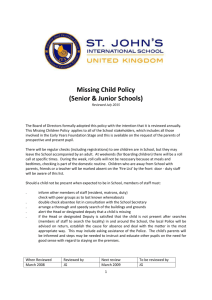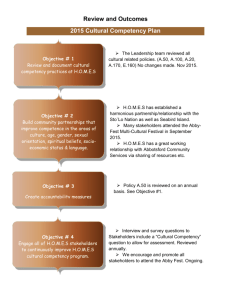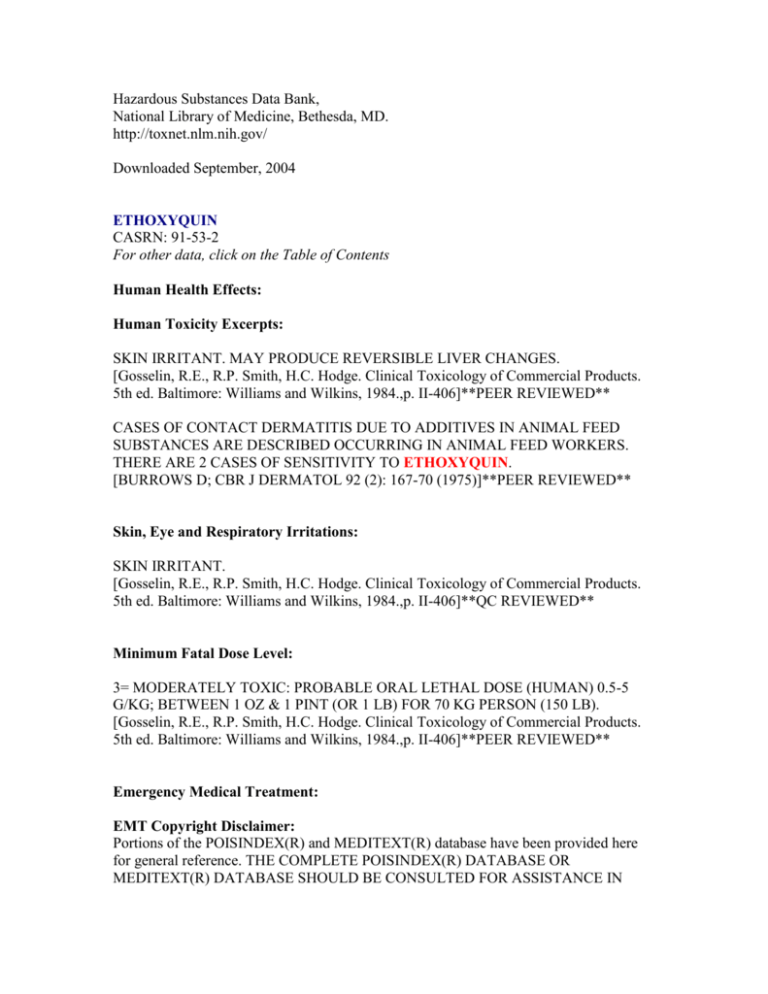
Hazardous Substances Data Bank,
National Library of Medicine, Bethesda, MD.
http://toxnet.nlm.nih.gov/
Downloaded September, 2004
ETHOXYQUIN
CASRN: 91-53-2
For other data, click on the Table of Contents
Human Health Effects:
Human Toxicity Excerpts:
SKIN IRRITANT. MAY PRODUCE REVERSIBLE LIVER CHANGES.
[Gosselin, R.E., R.P. Smith, H.C. Hodge. Clinical Toxicology of Commercial Products.
5th ed. Baltimore: Williams and Wilkins, 1984.,p. II-406]**PEER REVIEWED**
CASES OF CONTACT DERMATITIS DUE TO ADDITIVES IN ANIMAL FEED
SUBSTANCES ARE DESCRIBED OCCURRING IN ANIMAL FEED WORKERS.
THERE ARE 2 CASES OF SENSITIVITY TO ETHOXYQUIN.
[BURROWS D; CBR J DERMATOL 92 (2): 167-70 (1975)]**PEER REVIEWED**
Skin, Eye and Respiratory Irritations:
SKIN IRRITANT.
[Gosselin, R.E., R.P. Smith, H.C. Hodge. Clinical Toxicology of Commercial Products.
5th ed. Baltimore: Williams and Wilkins, 1984.,p. II-406]**QC REVIEWED**
Minimum Fatal Dose Level:
3= MODERATELY TOXIC: PROBABLE ORAL LETHAL DOSE (HUMAN) 0.5-5
G/KG; BETWEEN 1 OZ & 1 PINT (OR 1 LB) FOR 70 KG PERSON (150 LB).
[Gosselin, R.E., R.P. Smith, H.C. Hodge. Clinical Toxicology of Commercial Products.
5th ed. Baltimore: Williams and Wilkins, 1984.,p. II-406]**PEER REVIEWED**
Emergency Medical Treatment:
EMT Copyright Disclaimer:
Portions of the POISINDEX(R) and MEDITEXT(R) database have been provided here
for general reference. THE COMPLETE POISINDEX(R) DATABASE OR
MEDITEXT(R) DATABASE SHOULD BE CONSULTED FOR ASSISTANCE IN
THE DIAGNOSIS OR TREATMENT OF SPECIFIC CASES. The use of the
POISINDEX(R) and MEDITEXT(R) databases is at your sole risk. The POISINDEX(R)
and MEDITEXT(R) databases are provided "AS IS" and "as available" for use, without
warranties of any kind, either expressed or implied. Micromedex makes no representation
or warranty as to the accuracy, reliability, timeliness, usefulness or completeness of any
of the information contained in the POISINDEX(R) and MEDITEXT(R) databases. ALL
IMPLIED WARRANTIES OF MERCHANTABILITY AND FITNESS FOR A
PARTICULAR PURPOSE OR USE ARE HEREBY EXCLUDED. Micromedex does
not assume any responsibility or risk for your use of the POISINDEX(R) or
MEDITEXT(R) databases. Copyright 1974-2004 Thomson MICROMEDEX. All Rights
Reserved. Any duplication, replication, "downloading," sale, redistribution or other use
for commercial purposes is a violation of Micromedex' rights and is strictly prohibited.
The following Overview, *** GENERAL OR UNKNOWN CHEMICAL ***, is relevant
for this HSDB record chemical.
Life Support:
o This overview assumes that basic life support measures
have been instituted.
Clinical Effects:
0.2.1 SUMMARY OF EXPOSURE
0.2.1.1 ACUTE EXPOSURE
A) A SPECIFIC REVIEW on the clinical effects and treatment
of individuals exposed to this agent HAS NOT YET BEEN
PREPARED. The following pertains to the GENERAL
EVALUATION and TREATMENT of individuals exposed to
potentially toxic chemicals.
B) GENERAL EVALUATION 1) Exposed individuals should have a careful, thorough
medical history and physical examination performed,
looking for any abnormalities. Exposure to chemicals
with a strong odor often results in such nonspecific
symptoms as headache, dizziness, weakness, and nausea.
C) IRRITATION 1) Many chemicals cause irritation of the eyes, skin, and
respiratory tract. In severe cases respiratory tract
irritation can progress to ARDS/acute lung injury,
which may be delayed in onset for up to 24 to 72 hours
in some cases.
2) Irritation or burns of the esophagus or
gastrointestinal tract are also possible if caustic or
irritant chemicals are ingested.
D) HYPERSENSITIVITY 1) A number of chemical agents produce an allergic
hypersensitivity dermatitis or asthma with
bronchospasm and wheezing with chronic exposure.
Laboratory:
A) A number of chemicals produce abnormalities of the
hematopoietic system, liver, and kidneys. Monitoring
complete blood count, urinalysis, and liver and kidney
function tests is suggested for patients with significant
exposure.
B) If respiratory tract irritation or respiratory depression
is evident, monitor arterial blood gases, chest x-ray,
and pulmonary function tests.
Treatment Overview:
0.4.2 ORAL EXPOSURE
A) GASTRIC LAVAGE
1) Significant esophageal or gastrointestinal tract
irritation or burns may occur following ingestion. The
possible benefit of early removal of some ingested
material by cautious gastric lavage must be weighed
against potential complications of bleeding or
perforation.
2) GASTRIC LAVAGE: Consider after ingestion of a
potentially life-threatening amount of poison if it can
be performed soon after ingestion (generally within 1
hour). Protect airway by placement in Trendelenburg and
left lateral decubitus position or by endotracheal
intubation. Control any seizures first.
a) CONTRAINDICATIONS: Loss of airway protective reflexes
or decreased level of consciousness in unintubated
patients; following ingestion of corrosives;
hydrocarbons (high aspiration potential); patients at
risk of hemorrhage or gastrointestinal perforation;
and trivial or non-toxic ingestion.
B) ACTIVATED CHARCOAL
1) Activated charcoal binds most toxic agents and can
decrease their systemic absorption if administered soon
after ingestion. In general, metals and acids are
poorly bound and patients ingesting these materials
will not likely benefit from activated charcoal
administration.
a) Activated charcoal should not be given to patients
ingesting strong acidic or basic caustic chemicals.
Activated charcoal is also of unproven value in
patients ingesting irritant chemicals, where it may
obscure endoscopic findings when the procedure is
justified.
2) ACTIVATED CHARCOAL: Administer charcoal as a slurry
(240 mL water/30 g charcoal). Usual dose: 25 to 100 g
in adults/adolescents, 25 to 50 g in children (1 to 12
years), and 1 g/kg in infants less than 1 year old.
C) DILUTION 1) Immediate dilution with milk or water may be of benefit
in caustic or irritant chemical ingestions.
2) DILUTION: Immediately dilute with 4 to 8 ounces (120 to
240 mL) of water or milk (not to exceed 4 ounces/120 mL
in a child).
D) IRRITATION 1) Observe patients with ingestion carefully for the
possible development of esophageal or gastrointestinal
tract irritation or burns. If signs or symptoms of
esophageal irritation or burns are present, consider
endoscopy to determine the extent of injury.
E) OBSERVATION CRITERIA 1) Carefully observe patients with ingestion exposure for
the development of any systemic signs or symptoms and
administer symptomatic treatment as necessary.
2) Patients symptomatic following exposure should be
observed in a controlled setting until all signs and
symptoms have fully resolved.
0.4.3 INHALATION EXPOSURE
A) DECONTAMINATION 1) INHALATION: Move patient to fresh air. Monitor for
respiratory distress. If cough or difficulty breathing
develops, evaluate for respiratory tract irritation,
bronchitis, or pneumonitis. Administer oxygen and
assist ventilation as required. Treat bronchospasm with
inhaled beta2 agonist and oral or parenteral
corticosteroids.
B) IRRITATION 1) Respiratory tract irritation, if severe, can progress
to pulmonary edema which may be delayed in onset up to
24 to 72 hours after exposure in some cases.
C) ACUTE LUNG INJURY 1) ACUTE LUNG INJURY: Maintain ventilation and oxygenation
and evaluate with frequent arterial blood gas or pulse
oximetry monitoring. Early use of PEEP and mechanical
ventilation may be needed.
D) BRONCHOSPASM 1) If bronchospasm and wheezing occur, consider treatment
with inhaled sympathomimetic agents.
E) OBSERVATION CRITERIA 1) Carefully observe patients with inhalation exposure for
the development of any systemic signs or symptoms and
administer symptomatic treatment as necessary.
2) Patients symptomatic following exposure should be
observed in a controlled setting until all signs and
symptoms have fully resolved.
0.4.4 EYE EXPOSURE
A) DECONTAMINATION: Irrigate exposed eyes with copious
amounts of room temperature water for at least 15
minutes. If irritation, pain, swelling, lacrimation, or
photophobia persist, the patient should be seen in a
health care facility.
0.4.5 DERMAL EXPOSURE
A) OVERVIEW
1) DERMAL DECONTAMINATION a) DECONTAMINATION: Remove contaminated clothing and wash
exposed area thoroughly with soap and water. A
physician may need to examine the area if irritation
or pain persists.
2) PESTICIDES a) DECONTAMINATION: Remove contaminated clothing and
jewelry. Wash the skin, including hair and nails,
vigorously; do repeated soap washings. Discard
contaminated clothing.
3) IRRITATION a) Treat dermal irritation or burns with standard topical
therapy. Patients developing dermal hypersensitivity
reactions may require treatment with systemic or
topical corticosteroids or antihistamines.
4) DERMAL ABSORPTION a) Some chemicals can produce systemic poisoning by
absorption through intact skin. Carefully observe
patients with dermal exposure for the development of
any systemic signs or symptoms and administer
symptomatic treatment as necessary.
Range of Toxicity:
A) No specific range of toxicity can be established for the
broad field of chemicals in general.
[Rumack BH POISINDEX(R) Information System Micromedex, Inc., Englewood, CO,
2004; CCIS Volume 122, edition expires Nov, 2004. Hall AH & Rumack BH (Eds):
TOMES(R) Information System Micromedex, Inc., Englewood, CO, 2004; CCIS Volume
122, edition expires Nov, 2004.]**PEER REVIEWED**
Animal Toxicity Studies:
Non-Human Toxicity Excerpts:
ITS CHRONIC TOXICITY IS APPARENTLY LOW, 0.2% IN DIET CAUSING
TRANSIENT DEPRESSION IN GROWTH RATE OF RATS. AT AUTOPSY,
DAMAGE WAS APPARENT IN KIDNEYS, LIVER & THYROID GLAND IN MANY
MALES BUT IN NONE OF FEMALES ... .
[Garner's Veterinary Toxicology. 3rd ed., rev. by E.G.C. Clarke and M.L. Clarke.
Baltimore: Williams and Wilkins, 1967. 286]**PEER REVIEWED**
/IN RATS FED A DIET CONTAINING 0.2% OF SANTOQUIN/ SOME TUMORS
WERE FOUND AFTER CONTINUOUS ADMIN ... .
[Garner's Veterinary Toxicology. 3rd ed., rev. by E.G.C. Clarke and M.L. Clarke.
Baltimore: Williams and Wilkins, 1967. 287]**PEER REVIEWED**
ORAL ADMIN OF ETHOXYQUIN TO RATS INCR EPOXIDE HYDRATASE
ACTIVITY IN LIVER MICROSOMES. T/2 OF INCR 3-4 DAYS. AN INCR OF THIS
ENZYME WAS ALSO PRODUCED IN MICE BY IP ADMIN.
[KAHL R; BIOCHEM BIOPHYS RES COMMUN 95 (1): 163-9 (1980)]**PEER
REVIEWED**
DIETARY ADMIN OF 0.5% ETHOXYQUIN MARKEDLY ENHANCED RAT
HEPATIC UDP-GLUCURONOSYLTRANSFERASE ACTIVITIES.
[BOCK KW ET AL; NAUNYN-SCHMIEDEBERG'S ARCH PHARMACOL 310 (3):
249-52 (1980)]**PEER REVIEWED**
TERATOGENICITY STUDIES WERE CONDUCTED IN RATS TREATED ORALLY
FROM DAYS 6-15 OF GESTATION WITH SINGLE DAILY DOSES OF 125-500
MG/KG OF ETHOXYQUIN. DAMS WERE KILLED ON 22ND DAY OF
GESTATION. FETUSES SHOWED NO ADVERSE EFFECT TO TREATMENT.
[KHERA KS; J ENVIRON SCI HEALTH PART B PESTIC FOOD CONTAM AGRIC
WASTES 14 (6): 563-78 (1979)]**PEER REVIEWED**
TOXICITY OF ETHOXYQUIN FOR CHICK WAS SIGNIFICANTLY GREATER
WHEN DIET WAS LOW IN PROTEIN.
[MARCH BE ET AL; CAN J PHYSIOL PHARMACOL 46 (2): 145-9 (1968)]**PEER
REVIEWED**
ETHOXYQUIN INCR NUMBER OF CIRCULATING RETICULOCYTES WHEN
ADDED TO DIET OF CHICKENS. HEMATOCRIT VALUES WERE NOT REDUCED
& ERYTHROCYTE LIFE-SPANS WERE NOT SHORTENED. RETICULOCYTOSIS
WAS ATTRIBUTED TO DELAYED LOSS OF RETICULAR MATERIAL FROM
MATURING ERYTHROCYTES.
[MARCH BE ET AL; SCIENCE 164 (3886): 1398-400 (1969)]**PEER REVIEWED**
MALE SPRAGUE-DAWLEY RATS WERE FED ANTIOXIDANTS AT CONCN
EQUAL TO HEMORRHAGIC 40 DAY MEDIAN LETHAL CONCN OF
BUTYLATED HYDROXYTOLUENE TO DETERMINE MECHANISM OF
BUTYLATED HYDROXYTOLUENE-INDUCED HEMORRHAGE. ETHOXYQUIN
CAUSED HEMORRHAGE SIMILAR TO BUTYLATED HYDROXYTOLUENE. IT IS
ASSUMED THAT THE HEMORRHAGES ARE ATTRIBUTABLE TO
STRUCTURAL CHARACTERISTICS & NOT TO THEIR ANTIOXIDANT
PROPERTIES.
[TAKAHASHI O, HIRAGA K; TOXICOL APPL PHARMACOL 46 (3): 811-4
(1978)]**PEER REVIEWED**
SANTOQUIN (ETHOXYQUIN) CAUSED 60% INHIBITION OF PGE2 SYNTHESIS
BY RAT INNER MEDULLA AT CONCN OF 0.01 MMOLAR.
[ZENSER TV, DAVIS BB; METAB CLIN EXP 27 (2): 227-33 (1978)]**PEER
REVIEWED**
SINGLE ORAL ADMIN OF ETHOXYQUIN (500 MG/KG) TO RATS CAUSED
ULTRASTRUCTURAL CHANGES IN LIVER CELLS INCL PROLIFERATION OF
SMOOTH ENDOPLASMIC RETICULUM, DILATED CISTERNAE OF
ENDOPLASMIC RETICULUM, DISORGANIZATION OF MITOCHONDRIAL
MEMBRANES & DESQUAMATION OF LINING CELLS.
[NAFSTAD I, SKAARE JU; TOXICOL LETT 1 (5-6): 295-9 (1978)]**PEER
REVIEWED**
Toxic oral doses produce a slowly developing depression lasting 4 to 6 days. Parenteral
administration produces convulsions, coma, and prompt death. Single sc doses of 5 to 10
mg led to nearly 100% mortality in treated groups of neonatal mice.
[Gosselin, R.E., R.P. Smith, H.C. Hodge. Clinical Toxicology of Commercial Products.
5th ed. Baltimore: Williams and Wilkins, 1984.,p. II-406]**PEER REVIEWED**
The chronic nephrotoxicity of ethoxyquin was studied. Fischer 344 rats were fed diets
containing 0 or 0.5% ethoxyquin for 4 weeks to 18 months. One group received the
ethoxyquin diet for 24 weeks then a control diet for 34 weeks to assess recovery. Feed
consumption and body weight were monitored. Animals were killed at selected times and
kidneys were examined histopathologically. Treated rats had lower body weight gains
than control rats, but feed consumption did not differ significantly between the groups.
Interstitial degeneration of the extremity of the renal papilla was seen in male rats after 4
weeks. After 12 to 14 weeks, the papillary lesion was more advanced and papillary
necrosis and pyelonephritis were seen; two of eight treated females showed a slight focal
loss of interstitial detail at the papillary tip. After 24 weeks, nearly all male rats exhibited
complete papillary necrosis with loss of part of the papilla and foci of mineralization in
the abscission layer. Pyelonephritis and urothelial hyperplasia were also seen.
Degeneration in female rats paralleled that of males at the 4 or 12 to 14 week points;
neither pyelonephritis nor urothelial hyperplasia was seen. All treated male rats at 58
weeks had papillary necrosis, pyelonephritis, urothelial hyperplasia, and moderately
severe chronic progressive nephropathy. Eight of nine females had varying degrees of
papillary tip interstitial degeneration, five exhibited mild pyelonephritis, and one
exhibited low B grade urothelial hyperplasia. At 18 mon, all treated males had complete
papillary necrosis with tissue loss and severe endstage chronic progressive nephropathy.
All treated females had interstitial degeneration of the papillary tip, but the lesion had not
progressed beyond the earlier stage. No evidence of recovery of the lesions was seen. /It
was/ concluded that ethoxyquin is a potent inducer of renal papillary necrosis in male
rats and that female rats are far less susceptible to its effects.
[Hard GC, Neal GE; Fundam and Appl Toxicol 18 (2): 278-87 (1992)]**PEER
REVIEWED**
Metabolism/Pharmacokinetics:
Metabolism/Metabolites:
MAJOR METABOLIC REACTION WAS DEETHYLATION OF ETHOXYQUIN
WHICH PRODUCED 6-HYDROXY-2,2,4-TRIMETHYL-1,2-DIHYDROQUINOLINE
& 2,2,4-TRIMETHYL-6-QUINOLINE. OTHER REACTIONS WERE
HYDROXYLATION TO FOUR DIFFERENT HYDROXYLATED METABOLITES &
ONE DIHYDROXYLATED METABOLITE.
[SKAARE JU, SOLHEIM E; XENOBIOTICA 9 (11): 649-57 (1979)]**PEER
REVIEWED**
An avg of 28 & 36% of dose of radioactivity was recovered in bile in 12 & 24 hr
respectively following intragastric admin of (14)C-ethoxyquin to bile duct cannulated
rats. Biliary radioactive substances included, in addn to unchanged ethoxyquin...8hydroxyethoxyquin; hydroxylated 8-hydroxyethoxyquin; 6-ethoxy-2,2,4trimethylquinolone; hydroxylated 6-ethoxy-2,2,4-trimethyl-8-quinolone; 6-ethoxy-2,4dimethylquinoline; and 2,2,4-trimethyl-6-quinolone.
[The Royal Society of Chemistry. Foreign Compound Metabolism in Mammals. Volume
6: A Review of the Literature Published during 1978 and 1979. London: The Royal
Society of Chemistry, 1981. 297]**PEER REVIEWED**
Absorption, Distribution & Excretion:
FEEDING TRIAL IN COWS WAS CONDUCTED TO DETERMINE WHETHER
ETHOXYQUIN OR ITS RESIDUES ARE TRANSFERRED FROM FEED TO MILK
WHEN ADDED TO COW FEED AT 0.015% OF DRY MATTER INTAKE. LESS
THAN 7 UG ETHOXYQUIN/L WAS DETECTED IN MILK BY FLUORIMETRY &
BY THIN-LAYER CHROMATOGRAPHY.
[DUNKLEY WL ET AL; J DAIRY SCI 51 (8): 1215-8 (1968)]**PEER REVIEWED**
(14)C-ETHOXYQUIN WAS DISTRIBUTED THROUGHOUT MOST TISSUES &
BLOOD AT 0.5 HR AFTER ADMIN TO RATS. HIGHEST RADIOACTIVITY
THROUGHOUT EXPERIMENT WAS OBSERVED IN LIVER, KIDNEY, GI TRACT
& ADIPOSE TISSUE. THERE WAS NO ACTIVITY IN CNS. OF DOSE INGESTED
BY RAT 2.2 & 0.2% WERE FOUND IN LIVER AT 0.5 HR & 6 DAYS
RESPECTIVELY FOLLOWING DOSE. HEPATIC PEAK IN RADIOACTIVITY WAS
MEASURED AT 8 HR; & AFTER 6 DAYS 7.5% OF THIS LEVEL WAS STILL
PRESENT IN LIVER. 6 DAYS AFTER ADMIN TO RATS RESIDUES OF
ETHOXYQUIN & METABOLITES WERE PRESENT IN KIDNEY CORTEX,
INTESTINES, LUNG, VARIOUS ADIPOSE TISSUES & BLOOD.
[SKAARE JU, NAFSTAD I; ACTA PHARMACOL TOXICOL 44 (4): 303-7
(1979)]**PEER REVIEWED**
The compound is readily absorbed, metabolized, and excreted in urine and feces.
[Gosselin, R.E., R.P. Smith, H.C. Hodge. Clinical Toxicology of Commercial Products.
5th ed. Baltimore: Williams and Wilkins, 1984.,p. II-406]**PEER REVIEWED**
Ethoxyquin residue levels in the mouse tissue were determined by the HPLCfluorometric detection method. Mice were given powdered feed containing 0, 0.125, and
0.5% ethoxyquin hydrochloric acid and the ethoxyquin residue levels in liver kidney,
lung, and brain tissues were determined after 2, 4, 6, 10, and 14 wk (4 mice/group). The
tissue samples were homogenized in 10 volumes (w/v) of acetonitrile-water (7:3 v/v)
centrifuged and the supernatants were stored in a freezer for 2-3 hr or until the two layers
separated; then the clear upper layers were analyzed. The mean ethoxyquin residue
levels in the tissue ranged 0.84-4.58 ug ethoxyquin/g liver and 0.11-0.92 ug
ethoxyquin/g brain. The relative weight of the liver (5.21-7.07% body weight) and the
hepatic glutathione level (5.99-7.83 uM GSH/g tissue) of mice that received ethoxyquin
were significantly higher than those of the controls (4.67-5.05% body weight and 4.305.78 uM GSH/g tissue, respectively). The mean hepatic mitochondrial glutathione levels
of the higher ethoxyquin feeding group following dietary administration of ethoxyquin
for 14 wk, was approximately twofold (1.68 nM GSH/mg protein) of both the control and
the lower ethoxyquin feeding groups (0.83 and 0.74 nM GSH/mg protein, respectively.
[Kim HL; J Toxicol Environ Health 33 (21): 229-36 (1991)]**PEER REVIEWED**
Interactions:
ELEVATION OF EPOXIDE HYDRATASE ACTIVITY IS OBTAINED BY IP OR
ORAL TREATMENT OF MICE WITH ETHOXYQUIN. THIS ELEVATION IS
PREVENTED BY CONCOMITANT TREATMENT WITH CYCLOHEXIMIDE.
[KAHL R; BIOCHEM BIOPHYS RES COMMUN 95 (1): 163-9 (1980)]**PEER
REVIEWED**
SINGLE ORAL DOSE OF ETHOXYQUIN (200 MG/KG) TO RATS INHIBITED
HEPATIC MICROSOMAL HYDROXYLATION OF THIABENDAZOLE, ANILINE &
BIPHENYL BY 65, 40 & 40% IN VITRO AT 1 HR AFTER DOSAGE. ORAL
ETHOXYQUIN (400 MG/KG) DELAYED ABSORPTION OF & DECR PLASMA
CONCN OF THIABENDAZOLE.
[WILSON CG ET AL; XENOBIOTICA 9 (6): 343-51 (1979)]**PEER REVIEWED**
The effects of dietary administration of ethoxyquin on aflatoxin B1 metabolism, DNA
adduct formation and removal and hepatic tumorigenesis were examined in male Fischer
rats. Rats were fed a semipurified diet containing 0.4% ethoxyquin for 1 wk, gavaged
with 250 ug of aflatoxin B1 per kg 5 times a wk during the next 2 wk, and finally restored
to the control diet 1 wk after cessation of dosing. At 4 mo, focal areas of hepatocellular
alteration were identified and quantitated by staining sections of liver for gammaglutamyl transpeptidase. Treatment with ethoxyquin reduced by greater than 95% both
area and volume of liver occupied by gamma-glutamyl transpeptidase-positive foci.
Utilizing the same multiple dosing protocol, patterns of covalent modifications of DNA
by aflatoxin B1 were determined. Ethoxyquin produced a dramatic reduction in the
binding of aflatoxin B1 to hepatic DNA: 18-fold initially and 3-fold at the end of the
dosing period. Although binding was detectable at 3 and 4 mo postdosing, no effect of
ethoxyquin was observed, suggesting that these persistent adducts are not of primary
relevance to aflatoxin B1 carcinogenesis. Analysis of nucleic acid bases by highperformance liquid chromatography revealed no qualitative differences in adduct species
between treatment groups. The inhibitory effect of ethoxyquin on aflatoxin B1 binding
to DNA and tumorigenesis appears related to induction of detoxication enzymes. Rats fed
0.4% ethoxyquin for 7 days showed a 5-fold increase in hepatic cytosolic glutathione Stransferase (GST)-specific activities. Multiple molecular forms of glutathione Stransferase were induced, and concomitant elevations in messenger RNA levels coding
for the synthesis of glutathione S-transferase subunits were observed. Correspondingly,
billary elimination of aflatoxin B1-glutathione conjugate was increased 4.5-fold in
animals on the ethoxyquin diet during the first 2 hr following oral administration of 250
micrograms of aflatoxin B1 per kg. Thus, induction by ethoxyquin of enzymes important
to aflatoxin B1 detoxication, such as glutathione S-transferase can lead to enhanced
carcinogen elimination, as well as reductions of aflatoxin B1-DNA adduct formation and
subsequent expression of preneoplastic lesions, and, ultimately, neoplasia.
[Kensler et al; Cancer Res 46 (8): 3924-31 (1986)]**PEER REVIEWED**
Pharmacology:
Therapeutic Uses:
(VET): Ethoxyquin is added to animal feeds at 0.015% as an antioxidant ... to help
prevent encephalomalacia in growing chickens.
[Booth, N.H., L.E. McDonald (eds.). Veterinary Pharmacology and Therapeutics. 5th ed.
Ames, Iowa: Iowa State University Press, 1982. 1096]**QC REVIEWED**
(VET): SANTOQUIN HAS BEEN SUCCESSFULLY USED WITH VITAMIN E IN
TREATMENT OF WHITE MUSCLE DISEASE IN LAMBS.
[Garner's Veterinary Toxicology. 3rd ed., rev. by E.G.C. Clarke and M.L. Clarke.
Baltimore: Williams and Wilkins, 1967. 286]**QC REVIEWED**
Vitamin E and also several synthetic antioxidants, such as ... ethoxyquin, have modified
tumor induction by certain carcinogens in a number of target organs. However, inhibition
was achieved at high doses at which induction of biotransformation enzymes also occurs
with the synthetics and, therefore, inhibition may not be due solely to antioxidant effects.
[Amdur, M.O., J. Doull, C.D. Klaasen (eds). Casarett and Doull's Toxicology. 4th ed.
New York, NY: Pergamon Press, 1991. 152]**PEER REVIEWED**
Interactions:
ELEVATION OF EPOXIDE HYDRATASE ACTIVITY IS OBTAINED BY IP OR
ORAL TREATMENT OF MICE WITH ETHOXYQUIN. THIS ELEVATION IS
PREVENTED BY CONCOMITANT TREATMENT WITH CYCLOHEXIMIDE.
[KAHL R; BIOCHEM BIOPHYS RES COMMUN 95 (1): 163-9 (1980)]**PEER
REVIEWED**
SINGLE ORAL DOSE OF ETHOXYQUIN (200 MG/KG) TO RATS INHIBITED
HEPATIC MICROSOMAL HYDROXYLATION OF THIABENDAZOLE, ANILINE &
BIPHENYL BY 65, 40 & 40% IN VITRO AT 1 HR AFTER DOSAGE. ORAL
ETHOXYQUIN (400 MG/KG) DELAYED ABSORPTION OF & DECR PLASMA
CONCN OF THIABENDAZOLE.
[WILSON CG ET AL; XENOBIOTICA 9 (6): 343-51 (1979)]**PEER REVIEWED**
The effects of dietary administration of ethoxyquin on aflatoxin B1 metabolism, DNA
adduct formation and removal and hepatic tumorigenesis were examined in male Fischer
rats. Rats were fed a semipurified diet containing 0.4% ethoxyquin for 1 wk, gavaged
with 250 ug of aflatoxin B1 per kg 5 times a wk during the next 2 wk, and finally restored
to the control diet 1 wk after cessation of dosing. At 4 mo, focal areas of hepatocellular
alteration were identified and quantitated by staining sections of liver for gammaglutamyl transpeptidase. Treatment with ethoxyquin reduced by greater than 95% both
area and volume of liver occupied by gamma-glutamyl transpeptidase-positive foci.
Utilizing the same multiple dosing protocol, patterns of covalent modifications of DNA
by aflatoxin B1 were determined. Ethoxyquin produced a dramatic reduction in the
binding of aflatoxin B1 to hepatic DNA: 18-fold initially and 3-fold at the end of the
dosing period. Although binding was detectable at 3 and 4 mo postdosing, no effect of
ethoxyquin was observed, suggesting that these persistent adducts are not of primary
relevance to aflatoxin B1 carcinogenesis. Analysis of nucleic acid bases by highperformance liquid chromatography revealed no qualitative differences in adduct species
between treatment groups. The inhibitory effect of ethoxyquin on aflatoxin B1 binding
to DNA and tumorigenesis appears related to induction of detoxication enzymes. Rats fed
0.4% ethoxyquin for 7 days showed a 5-fold increase in hepatic cytosolic glutathione Stransferase (GST)-specific activities. Multiple molecular forms of glutathione Stransferase were induced, and concomitant elevations in messenger RNA levels coding
for the synthesis of glutathione S-transferase subunits were observed. Correspondingly,
billary elimination of aflatoxin B1-glutathione conjugate was increased 4.5-fold in
animals on the ethoxyquin diet during the first 2 hr following oral administration of 250
micrograms of aflatoxin B1 per kg. Thus, induction by ethoxyquin of enzymes important
to aflatoxin B1 detoxication, such as glutathione S-transferase can lead to enhanced
carcinogen elimination, as well as reductions of aflatoxin B1-DNA adduct formation and
subsequent expression of preneoplastic lesions, and, ultimately, neoplasia.
[Kensler et al; Cancer Res 46 (8): 3924-31 (1986)]**PEER REVIEWED**
Minimum Fatal Dose Level:
3= MODERATELY TOXIC: PROBABLE ORAL LETHAL DOSE (HUMAN) 0.5-5
G/KG; BETWEEN 1 OZ & 1 PINT (OR 1 LB) FOR 70 KG PERSON (150 LB).
[Gosselin, R.E., R.P. Smith, H.C. Hodge. Clinical Toxicology of Commercial Products.
5th ed. Baltimore: Williams and Wilkins, 1984.,p. II-406]**PEER REVIEWED**
Environmental Fate & Exposure:
Environmental Standards & Regulations:
FIFRA Requirements:
As the federal pesticide law FIFRA directs, EPA is conducting a comprehensive review
of older pesticides to consider their health and environmental effects and make decisions
about their future use. Under this pesticide reregistration program, EPA examines health
and safety data for pesticide active ingredients initially registered before November 1,
1984, and determines whether they are eligible for reregistration. In addition, all
pesticides must meet the new safety standard of the Food Quality Protection Act of 1996.
Ethoxyquin is found on List A, which contains most food use pesticides and consists of
the 194 chemical cases (or 350 individual active ingredients) for which EPA issued
registration standards prior to FIFRA, as amended in 1988. Case No: 0003; Pesticide
type: Herbicide; Registration Standard Date: 03/01/81; Case Status: OPP is reviewing
data from the pesticide's producers regarding its human health and/or environmental
effects, or OPP is determining the pesticide's eligibility for reregistration and developing
the Reregistration Eligibility Decision (RED) document.; Active ingredient (AI):
Ethoxyquin; Data Call-in (DCI) Date(s): 08/20/90, 10/13/95; AI Status: The producers
of the pesticide has made commitments to conduct the studies and pay the fees required
for reregistration, and are meeting those commitments in a timely manner.
[USEPA/OPP; Status of Pesticides in Registration, Reregistration and Special Review
p.118 (Spring, 1998) EPA 738-R-98-002]**QC REVIEWED**
A tolerance is established for residues of the plant regulator ethoxyquin (1,2-dihydro-6ethoxy-2,2,4-trimethylquinoline) from preharvest or postharvest use in or on apples and
pears.
[40 CFR 180.178 (4/1/92)]**PEER REVIEWED**
FDA Requirements:
Ethoxyquin is a food additive permitted for direct addition to food for human
consumption, as long as 1) the quantity added to food does not exceed the amount
reasonably required to accomplish its intended physical, nutritive, or other technical
effect in food, and 2) when intended for use in or on food it is of appropriate food grade
and is prepared and handled as a food ingredient.
[21 CFR 172.140 (4/1/93)]**PEER REVIEWED**
Ethoxyquin in animal feeds may be safely used in accordance with conditions prescribed
in 21 CFR Part 573.
[21 CFR 573.380 (4/1/93)]**PEER REVIEWED**
Ethoxyquin in certain dehydrated forage crops may be safely used in accordance with
conditions prescribed in 21 CFR Part 573.
[21 CFR 573.400 (4/1/93)]**PEER REVIEWED**
Allowable Tolerances:
A tolerance of 3 ppm is established for residues of the plant regulator ethoxyquin (1,2dihydro -6-ethoxy -2,2,4-trimethylquinoline)from preharvest or postharvest use in or on
apples and pears.
[40 CFR 180.178 (4/1/92)]**PEER REVIEWED**
Chemical/Physical Properties:
Molecular Formula:
C14-H19-N-O
**PEER REVIEWED**
Molecular Weight:
217.30
[Budavari, S. (ed.). The Merck Index - Encyclopedia of Chemicals, Drugs and
Biologicals. Rahway, NJ: Merck and Co., Inc., 1989. 593]**PEER REVIEWED**
Color/Form:
YELLOW LIQUID
[Budavari, S. (ed.). The Merck Index - Encyclopedia of Chemicals, Drugs and
Biologicals. Rahway, NJ: Merck and Co., Inc., 1989. 593]**PEER REVIEWED**
Boiling Point:
123-125 DEG C AT 2 MM HG
[Budavari, S. (ed.). The Merck Index - Encyclopedia of Chemicals, Drugs and
Biologicals. Rahway, NJ: Merck and Co., Inc., 1989. 593]**PEER REVIEWED**
Melting Point:
Approximately 0 deg C
[Sax, N.I. and R.J. Lewis, Sr. (eds.). Hawley's Condensed Chemical Dictionary. 11th ed.
New York: Van Nostrand Reinhold Co., 1987. 476]**PEER REVIEWED**
Density/Specific Gravity:
1.029-1.031 AT 25 DEG C/25 DEG C
[Budavari, S. (ed.). The Merck Index - Encyclopedia of Chemicals, Drugs and
Biologicals. Rahway, NJ: Merck and Co., Inc., 1989. 593]**PEER REVIEWED**
Spectral Properties:
INDEX OF REFRACTION: 1.569-1.672 AT 25 DEG C/D
[Budavari, S. (ed.). The Merck Index - Encyclopedia of Chemicals, Drugs and
Biologicals. Rahway, NJ: Merck and Co., Inc., 1989. 593]**PEER REVIEWED**
MAX ABSORPTION: 354 NM
[Sunshine, I. (ed.). CRC Handbook of Analytical Toxicology. Cleveland: The Chemical
Rubber Co., 1969. 264]**PEER REVIEWED**
Intense mass spectral peaks: 202 m/z (100%), 108 m/z (53%), 174 m/z (48%), 137 m/z
(36%)
[Hites, R.A. Handbook of Mass Spectra of Environmental Contaminants. Boca Raton,
FL: CRC Press Inc., 1985. 387]**PEER REVIEWED**
Vapor Density:
7.48 (AIR= 1)
[Sax, N.I. Dangerous Properties of Industrial Materials. 5th ed. New York: Van Nostrand
Rheinhold, 1979. 647]**PEER REVIEWED**
Chemical Safety & Handling:
Skin, Eye and Respiratory Irritations:
SKIN IRRITANT.
[Gosselin, R.E., R.P. Smith, H.C. Hodge. Clinical Toxicology of Commercial Products.
5th ed. Baltimore: Williams and Wilkins, 1984.,p. II-406]**QC REVIEWED**
Fire Potential:
FIRE HAZARD /IS/ SLIGHT
[Sax, N.I. Dangerous Properties of Industrial Materials. 5th ed. New York: Van Nostrand
Rheinhold, 1979. 647]**PEER REVIEWED**
Hazardous Reactivities & Incompatibilities:
Can react with oxidizing materials.
[Sax, N.I. Dangerous Properties of Industrial Materials. 5th ed. New York: Van Nostrand
Rheinhold, 1979. 647]**PEER REVIEWED**
Hazardous Decomposition:
... WHEN HEATED TO DECOMP, EMITS TOXIC FUMES ... .
[Sax, N.I. Dangerous Properties of Industrial Materials. 5th ed. New York: Van Nostrand
Rheinhold, 1979. 647]**PEER REVIEWED**
Stability/Shelf Life:
DISCOLORS & STAINS BADLY
[Hawley, G.G. The Condensed Chemical Dictionary. 10th ed. New York: Van Nostrand
Reinhold Co., 1981. 421]**PEER REVIEWED**
Disposal Methods:
SRP: At the time of review, criteria for land treatment or burial (sanitary landfill)
disposal practices are subject to significant revision. Prior to implementing land disposal
of waste residue (including waste sludge), consult with environmental regulatory
agencies for guidance on acceptable disposal practices.
**PEER REVIEWED**
Occupational Exposure Standards:
Manufacturing/Use Information:
Major Uses:
For ethoxyquin (USEPA/OPP Pesticide Code: 055501) ACTIVE products with label
matches. /SRP: Registered for use in the U.S. but approved pesticide uses may change
periodically and so federal, state and local authorities must be consulted for currently
approved uses./
[U.S. Environmental Protection Agency/Office of Pesticide Program's Chemical
Ingredients Database on Ethoxyquin (91-53-2). Available from the Database Query page
at http://www.cdpr.ca.gov/docs/epa/epamenu.htm as of October 24, 2002.]**QC
REVIEWED**
MEDICATION (VET):
**QC REVIEWED**
ANTIOXIDANT IN FEED & FOOD; ANTIDEGRADATION AGENT FOR RUBBER
[Budavari, S. (ed.). The Merck Index - Encyclopedia of Chemicals, Drugs and
Biologicals. Rahway, NJ: Merck and Co., Inc., 1989. 593]**PEER REVIEWED**
Antioxidant, used as post-harvest fruit-drop to prevent common scald of apples & pears
in storge; Formerly added to poultry feeds & forage crops
[Gosselin, R.E., R.P. Smith, H.C. Hodge. Clinical Toxicology of Commercial Products.
5th ed. Baltimore: Williams and Wilkins, 1984.,p. II-406]**PEER REVIEWED**
Insecticide; antioxidant; flex-cracking inhibitor; post-harvest preservation of apples
(scald inhibitor)
[Sax, N.I. and R.J. Lewis, Sr. (eds.). Hawley's Condensed Chemical Dictionary. 11th ed.
New York: Van Nostrand Reinhold Co., 1987. 476]**PEER REVIEWED**
TO PRESERVE COLOR OF PAPRIKA, CHILI POWDER & GROUND CHILI
[Furia, T.E. (ed.). CRC Handbook of Food Additives. 2nd ed. Cleveland: The Chemical
Rubber Co., 1972. 215]**PEER REVIEWED**
Used as a fruit dip for prevention of common (superficial) scald in apples
[Hartley, D. and H. Kidd (eds.). The Agrochemicals Handbook. 2nd ed. Lechworth,
Herts, England: The Royal Society of Chemistry, 1987.,p. A435]**PEER REVIEWED**
Antioxidant for rubbers
[Kirk-Othmer Encyclopedia of Chemical Technology. 4th ed. Volumes 1: New York,
NY. John Wiley and Sons, 1991-Present.,p. V31 444]**PEER REVIEWED**
Antioxidant for food
[Gerhartz, W. (exec ed.). Ullmann's Encyclopedia of Industrial Chemistry. 5th ed.Vol
A1: Deerfield Beach, FL: VCH Publishers, 1985 to Present.,p. A11 568]**PEER
REVIEWED**
Used to retard the oxidation of vitamins A and E, carotene, xanthophyll pigments, and to
stabilize rendered animal fats and vegetable oils in animal feeds
[Kirk-Othmer Encyclopedia of Chemical Technology. 3rd ed., Volumes 1-26. New York,
NY: John Wiley and Sons, 1978-1984.,p. V3 140]**PEER REVIEWED**
MEDICATION
**QC REVIEWED**
Manufacturers:
Monsanto Company, Hq, 800 N Lindbergh Blvd, St Louis, MO 63167, (314) 694-1000;
Chemical group, 800 N Lindbergh Blvd, St Louis, MO 63167, (314) 694-1000;
Production site: Nitro, WV 25143
[SRI. 1994 Directory of Chemical Producers -United States of America. Menlo Park, CA:
SRI International, 1994.. 890]**PEER REVIEWED**
Methods of Manufacturing:
/BY PASSING ACETONE VAPOR INTO P-PHENETIDINE CONTAINING 1% OF
IODINE @ 120-130 DEG C & SEPARATING BY DISTILLATION/
[The Merck Index. 10th ed. Rahway, New Jersey: Merck Co., Inc., 1983. 545]**PEER
REVIEWED**
General Manufacturing Information:
2,4-DIMETHYL-6-ETHOXYQUINOLINE, A REACTION PRODUCT OF
ETHOXYQUIN, OCCURS IN COMMERCIAL FEEDS & COULD INTERFERE IN
ANALYSIS OF MIXED COMMERCIAL FEEDS FOR AFLATOXIN.
[GALLAGHER RT, STAHR HM; J AGRIC FOOD CHEM 28 (1): 133-5
(1980)]**PEER REVIEWED**
THE USE OF ETHOXYQUIN AS FEED ADDITIVE MAY AGGRAVATE
POTENTIAL MYCOTOXIN HAZARDS IN CONTAMINATED FEEDSTUFFS BY
ALTERING THE TYPE & QUANTITY OF AFLATOXIN PRODUCED.
[FOUDIN AS ET AL; J FOOD SCI 43 (3): 731-4 (1978)]**PEER REVIEWED**
/ Stop Scald /trade name / discontinued
[Farm Chemicals Handbook 87. Willoughby, Ohio: Meister Publishing Co., 1987.,p. C109]**PEER REVIEWED**
Formulations/Preparations:
USEPA/OPP Pesticide Code 055501; Trade Names: Stop-scald.
[U.S. Environmental Protection Agency/Office of Pesticide Program's Chemical
Ingredients Database on Ethoxyquin (91-53-2). Available from the Database Query page
at http://www.cdpr.ca.gov/docs/epa/epamenu.htm as of October 24, 2002.]**QC
REVIEWED**
Emulsifiable concentrate
[Hartley, D. and H. Kidd (eds.). The Agrochemicals Handbook. 2nd ed. Lechworth,
Herts, England: The Royal Society of Chemistry, 1987.,p. A435]**PEER REVIEWED**
Laboratory Methods:
Analytic Laboratory Methods:
METHOD OF CHOICE IS FLUORESCENCE ASSAY WITH ISOOCTANE
SOLVENT, APPLICABLE TO MILK & TISSUE; EXCITATION WAVELENGTH
APPROX 365 NM WITH BLUE FLUORESCENCE. /FROM TABLE/
[Sunshine, I. (ed.). CRC Handbook of Analytical Toxicology. Cleveland: The Chemical
Rubber Co., 1969. 925]**PEER REVIEWED**
ETHOXYQUIN WAS DETECTED IN APPLE EXTRACTS BY HIGHPERFORMANCE LIQ CHROMATOGRAPHY ON A SPHERISORB 10 ODS
COLUMN USING 20:80 WATER-METHANOL AS MOBILE PHASE & A
FLUORIMETRIC DETECTOR. ETHOXYQUIN RECOVERY FROM SAMPLES
SPIKED WITH 0.1-1.0 MG ETHOXYQUIN/KG RANGED FROM 97.6-98.8% &
DETECTION LIMIT WAS APPROX 0.05 MG/KG.
[ERNST GF, VERVELD-ROEDER SY; J CHROMATOGR 174 (1): 269-71
(1979)]**PEER REVIEWED**
A RAPID & SIMPLE METHOD WAS DEVELOPED FOR THE NONDESTRUCTIVE
DISTINCTION BETWEEN AFLATOXIN B1 & ETHOXYQUIN. THEY EXHIBIT
SIMILAR RF VALUES IN CERTAIN SOLVENT SYSTEMS & PRODUCE SIMILAR
BLUISH FLUORESCENCE UNDER LONG UV (366 NM) RADIATION. THE
METHOD INVOLVES THE IN SITU GENERATION OF FLUORESCENCE
SPECTRA OF THE RESPECTIVE TLC SPOTS. SINCE IT IS NONDESTRUCTIVE,
THE METHOD AFFORDS ANCILLARY STUDY OF THE SEPARATED
AFLATOXINS.
[ISSAQ HJ ET AL; J CHROMATOGR 132 (1): 115-20 (1977)]**PEER REVIEWED**
Ethoxyquin extracted from paprika & chromatographed on a Dupont Zorbax ODS
column with ammonium acetate/acetonitrile as mobile phase is quantitated using an
ultraviolet spectrophotometer with detector set at 254 nm.
[Marmion, D.M. Handbook of U.S. Colorants for Foods, Drugs, and Cosmetics. 2nd Ed.
New York, NY: John Wiley and Sons, 1984. 301]**PEER REVIEWED**
Special References:
Synonyms and Identifiers:
Synonyms:
AMEA 100
**PEER REVIEWED**
ANTIOXIDANT EC
**PEER REVIEWED**
DAWE'S NUTRIGARD
**PEER REVIEWED**
1,2-DIHYDRO-6-ETHOXY-2,2,4-TRIMETHYLQUINOLINE
**PEER REVIEWED**
1,2-DIHYDRO-2,2,4-TRIMETHYL-6-ETHOXYQUINOLINE
**PEER REVIEWED**
EMQ
**PEER REVIEWED**
Pesticide Code 055501
**QC REVIEWED**
EQ
**PEER REVIEWED**
6-ETHOXY-1,2-DIHYDRO-2,2,4-TRIMETHYLQUINOLINE
**PEER REVIEWED**
ETHOXYQUINE
**PEER REVIEWED**
6-ETHOXY-2,2,4-TRIMETHYL-1,2-DIHYDROQUINOLINE
**PEER REVIEWED**
NIFLEX
**PEER REVIEWED**
Niflex D
**PEER REVIEWED**
NIX-SCALD
**PEER REVIEWED**
NOCRAC AW
**PEER REVIEWED**
PERMANAX 103
**PEER REVIEWED**
QUINOL ED
**PEER REVIEWED**
QUINOLINE, 6-ETHOXY-1,2-DIHYDRO-2,2,4-TRIMETHYL**PEER REVIEWED**
SANTOFLEX A
**PEER REVIEWED**
SANTOFLEX AW
**PEER REVIEWED**
SANTOQUIN
**PEER REVIEWED**
SANTOQUINE
**PEER REVIEWED**
STOP-SCALD
**PEER REVIEWED**
2,2,4-TRIMETHYL-6-ETHOXY-1,2-DIHYDROQUINOLINE
**PEER REVIEWED**
USAF B-24
**PEER REVIEWED**
Formulations/Preparations:
USEPA/OPP Pesticide Code 055501; Trade Names: Stop-scald.
[U.S. Environmental Protection Agency/Office of Pesticide Program's Chemical
Ingredients Database on Ethoxyquin (91-53-2). Available from the Database Query page
at http://www.cdpr.ca.gov/docs/epa/epamenu.htm as of October 24, 2002.]**QC
REVIEWED**
Emulsifiable concentrate
[Hartley, D. and H. Kidd (eds.). The Agrochemicals Handbook. 2nd ed. Lechworth,
Herts, England: The Royal Society of Chemistry, 1987.,p. A435]**PEER REVIEWED**
Administrative Information:
Hazardous Substances Databank Number: 400
Last Revision Date: 20030305
Last Review Date: Reviewed by SRP on 9/29/1994
Update History:
Complete Update on 03/05/2003, 4 fields added/edited/deleted.
Field Update on 02/14/2003, 1 field added/edited/deleted.
Field Update on 11/08/2002, 1 field added/edited/deleted.
Field Update on 08/06/2002, 1 field added/edited/deleted.
Field Update on 01/14/2002, 1 field added/edited/deleted.
Field Update on 08/08/2001, 1 field added/edited/deleted.
Field Update on 05/15/2001, 1 field added/edited/deleted.
Complete Update on 06/12/2000, 1 field added/edited/deleted.
Complete Update on 03/09/2000, 1 field added/edited/deleted.
Complete Update on 02/08/2000, 1 field added/edited/deleted.
Complete Update on 02/02/2000, 1 field added/edited/deleted.
Complete Update on 11/18/1999, 1 field added/edited/deleted.
Complete Update on 09/21/1999, 1 field added/edited/deleted.
Complete Update on 08/26/1999, 1 field added/edited/deleted.
Complete Update on 06/02/1998, 1 field added/edited/deleted.
Complete Update on 02/25/1998, 1 field added/edited/deleted.
Complete Update on 10/17/1997, 1 field added/edited/deleted.
Complete Update on 04/23/1997, 1 field added/edited/deleted.
Complete Update on 03/11/1997, 3 fields added/edited/deleted.
Complete Update on 02/07/1997, 1 field added/edited/deleted.
Complete Update on 01/24/1997, 1 field added/edited/deleted.
Complete Update on 05/10/1996, 1 field added/edited/deleted.
Complete Update on 01/19/1996, 1 field added/edited/deleted.
Complete Update on 10/19/1995, 1 field added/edited/deleted.
Complete Update on 04/25/1995, 1 field added/edited/deleted.
Complete Update on 01/12/1995, 32 fields added/edited/deleted.
Field Update on 12/21/1994, 1 field added/edited/deleted.
Field Update on 11/03/1994, 1 field added/edited/deleted.
Field Update on 11/02/1994, 1 field added/edited/deleted.
Field Update on 08/11/1994, 1 field added/edited/deleted.
Complete Update on 03/25/1994, 1 field added/edited/deleted.
Complete Update on 08/20/1993, 1 field added/edited/deleted.
Field update on 12/12/1992, 1 field added/edited/deleted.
Complete Update on 10/10/1990, 1 field added/edited/deleted.
Complete Update on 03/06/1990, 1 field added/edited/deleted.
Field update on 03/06/1990, 1 field added/edited/deleted.
Complete Update on 10/03/1986

